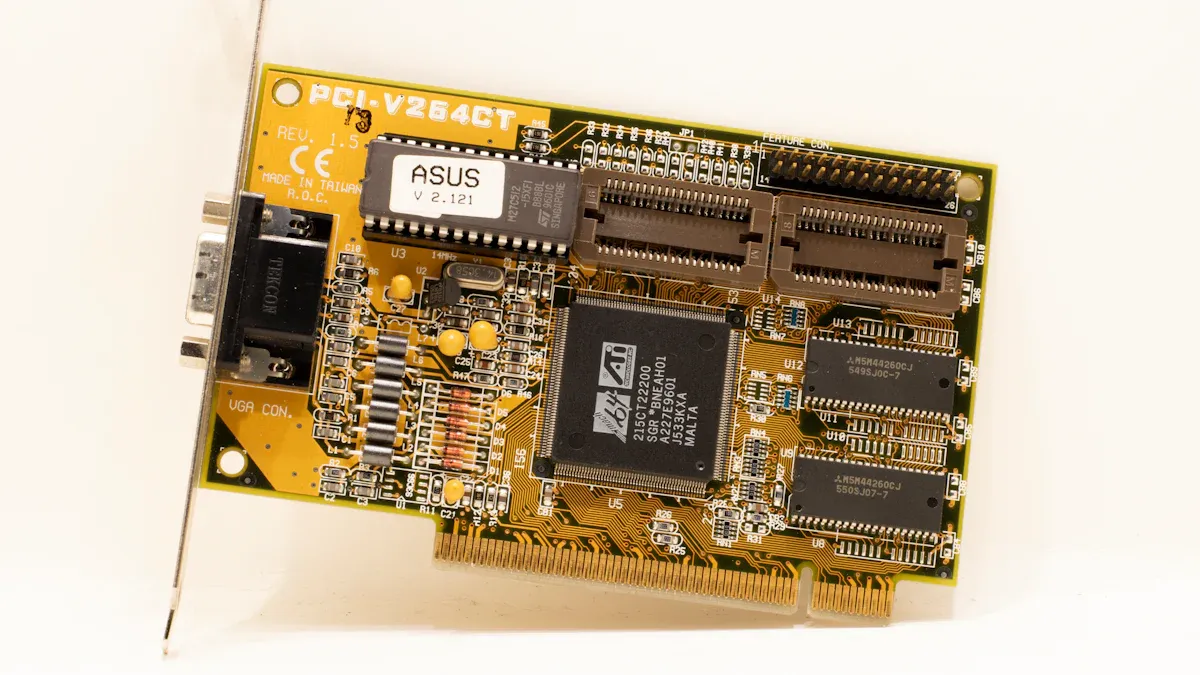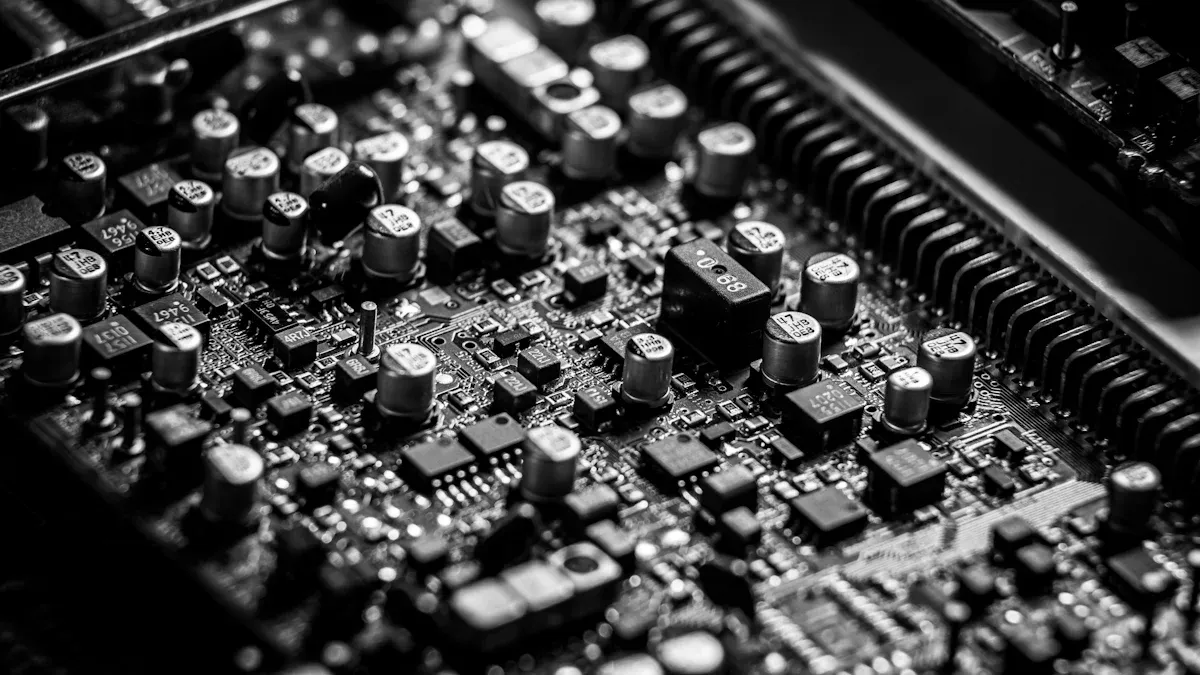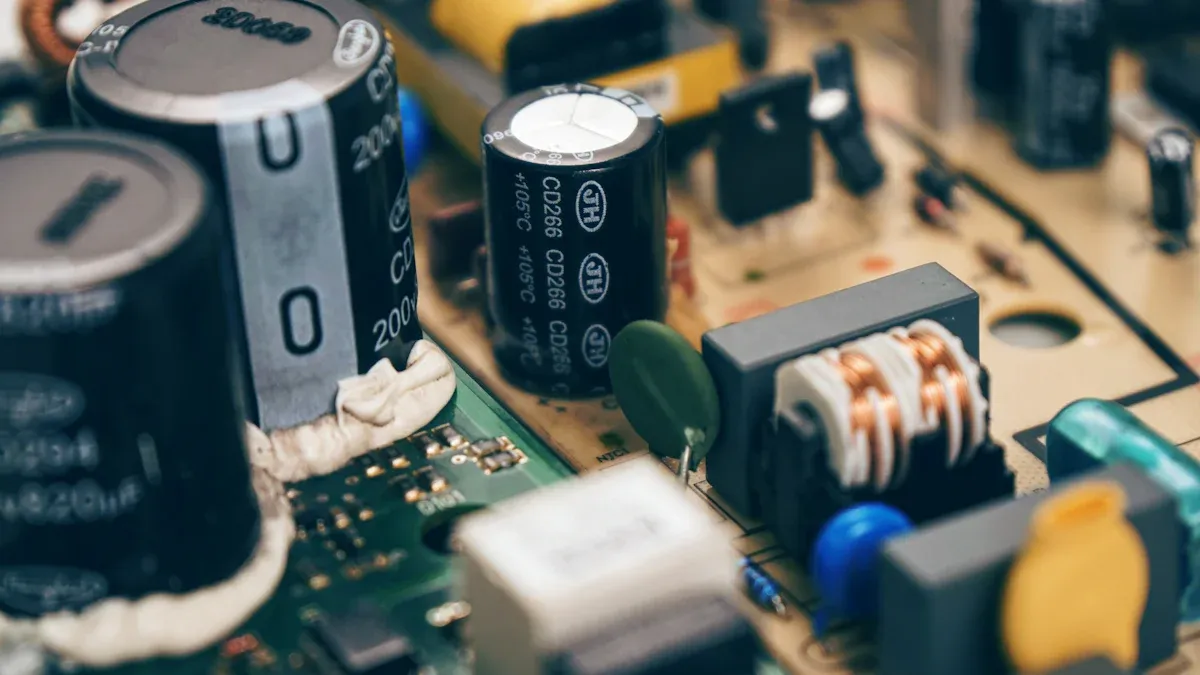Understanding the Historical Milestones of Capacitor Technology

Capacitors have shaped the way you experience modern electronics. They store electrical energy and ensure devices run smoothly during power fluctuations. For example:
Capacitors stabilize voltage in power systems, improving efficiency.
They filter signals in communication devices, ensuring clear audio and video.
Timing circuits rely on capacitors to control signal propagation.
The principle of capacitor technology dates back to the 18th century with the invention of the Leyden jar. This breakthrough allowed scientists to store electric charge, paving the way for innovations like supercapacitors and miniaturized components in today’s smartphones and laptops. Capacitors continue to drive advancements in energy storage and signal processing, making them indispensable in your daily life.
Key Takeaways
Capacitors help keep voltage steady and devices working smoothly.
The Leyden jar, made in the 1740s, was the first useful capacitor. It inspired today’s designs.
New types like electrolytic and ceramic capacitors store energy better and take up less space.
Supercapacitors store lots of energy, perfect for green energy and electric cars.
Future materials like graphene might make capacitors work even better and save more energy.
The Early History of Capacitors

The Principle of Capacitor in Early Discoveries
Thales of Miletus and the study of static electricity
The principle of capacitor technology can be traced back to the early days of electricity. Around 600 BCE, Thales of Miletus observed that rubbing amber with fur attracted lightweight objects like feathers. This marked one of the first recorded studies of static electricity. Although Thales didn’t fully understand the phenomenon, his observations laid the groundwork for future discoveries about electric charge.
Early experiments with amber and static charge
In the centuries that followed, scientists continued experimenting with static electricity. They discovered key principles, such as the existence of two types of charge—positive and negative—and how materials behave when rubbed together. These early findings helped shape the principle of capacitor technology, which relies on the storage and interaction of electric charges.
The Leyden Jar: The First Practical Capacitor
Invention by Pieter van Musschenbroek and Ewald von Kleist in the 1740s
The history of capacitors took a significant leap in 1745 when Ewald Georg von Kleist and Pieter van Musschenbroek independently invented the Leyden jar. Von Kleist found that a glass container filled with water could store an electric charge. Around the same time, Musschenbroek created a similar device at Leyden University, which became known as the Leyden jar. This invention marked the first practical application of the principle of capacitor technology.
How the Leyden jar demonstrated the principle of capacitor technology
The Leyden jar consisted of a glass jar coated with metal foil on the inside and outside, with a metal rod inserted through the lid. When charged, it could store and release electricity, demonstrating the ability to hold electric energy. This breakthrough laid the foundation for modern capacitors, which play a crucial role in electric circuits today.
Benjamin Franklin’s Contributions to the History of Capacitors
Franklin’s experiments with electricity and his work on capacitors
Benjamin Franklin expanded the understanding of the Leyden jar through his experiments. He demonstrated that the charge was stored on the glass itself, not in the water, highlighting the importance of dielectric materials in capacitors. Franklin also showed that the jar could discharge even when placed on an insulator, further proving the role of the glass in charge retention.
The introduction of the term "battery" in relation to capacitors
Franklin introduced the term "battery" to describe a series of connected Leyden jars. This terminology reflected the idea of combining multiple units to increase storage capacity. His work not only advanced the principle of capacitor technology but also influenced the broader history of capacitors, paving the way for future innovations.
Key Innovations in Capacitor Technology
Alessandro Volta and the Evolution of Capacitors
Volta’s work on electrical storage and the voltaic pile
Alessandro Volta made groundbreaking contributions to capacitor technology in the late 18th century. His experiments revealed that voltage and charge are proportional, a discovery that became the foundation for the law of capacitance. In 1782, Volta introduced the term "condenser" to describe devices that store electrical charge. This terminology influenced how capacitors are understood today.
Volta's work also led to the development of the voltaic pile, an early form of a battery. While not a capacitor itself, the voltaic pile demonstrated the importance of electrical storage in circuits. These innovations helped shape the role of capacitors in early electrical systems, enabling more efficient energy storage and transfer.
The role of capacitors in early electrical circuits
Capacitors began playing a critical role in early electrical circuits thanks to Volta's discoveries. By storing and releasing charge, they allowed circuits to function more reliably. This paved the way for advancements in electrical engineering and the development of more complex devices.
Michael Faraday and the Role of Dielectric Materials
Faraday’s discovery of the role of dielectrics in capacitors
Michael Faraday revolutionized capacitor design through his experiments with dielectric materials. He tested materials like air, glass, and wax between capacitor plates and observed that the charge increased when using these materials instead of air. This discovery introduced the concept of specific inductive capacity, which explains how different materials affect capacitance.
Faraday's work demonstrated that dielectrics enhance a capacitor's ability to store energy. This insight became a cornerstone of modern capacitor design, influencing how materials are selected for various applications.
How Faraday’s work laid the foundation for modern capacitor design
Faraday's findings on dielectrics provided a deeper understanding of how capacitors function. By identifying the relationship between materials and energy storage, he enabled the development of capacitors with higher efficiency and reliability. His contributions continue to impact capacitor technology today.
19th-Century Advancements in Capacitor Design
Development of practical capacitor designs for industrial use
The 19th century saw significant improvements in capacitor design. Engineers began using materials like glass, wax, and paper as dielectrics. These materials improved insulation between the plates, allowing capacitors to store more energy. This advancement made capacitors more practical for industrial applications, such as early radio technology and other electronic devices.
The introduction of paper and mica as dielectric materials
Paper and mica became popular dielectric materials during this period. Their availability and effectiveness made them ideal for enhancing capacitor performance. These innovations played a key role in the widespread adoption of capacitors in industrial and commercial settings.
The Evolution of Capacitor Designs
Electrolytic Capacitors and Miniaturization
Introduction of electrolytic capacitors in the early 20th century
Electrolytic capacitors emerged in the early 20th century, revolutionizing how you store electrical energy. These capacitors used an electrolyte as one of their key components, allowing them to achieve much higher capacitance values compared to earlier designs. This innovation made them ideal for applications requiring significant energy storage in a compact form.
Their impact on high-capacitance applications and miniaturization
Electrolytic capacitors played a pivotal role in advancing high-capacitance applications and miniaturization.
The introduction of surface-mount aluminum electrolytic capacitors marked a breakthrough in achieving high capacitance while maintaining a small size.
These capacitors became cost-effective solutions, meeting the growing demand for compact and efficient electronic devices.
Their versatility and compact design made them indispensable in modern electronics, from power supplies to audio systems.
Ceramic and Film Capacitors in Modern Electronics
Development of ceramic capacitors for high-frequency applications
Ceramic capacitors, particularly multilayer ceramic capacitors (MLCCs), have become essential in high-frequency applications.
MLCCs serve as the backbone of devices like smartphones, computers, and automotive electronics.
They enable miniaturization and high-capacity energy storage, crucial for compact modern devices.
The growing market for MLCCs highlights their increasing importance in electronic design.
Film capacitors and their versatility in various circuits
Film capacitors offer unique advantages that make them versatile in various circuits.
They provide higher voltage resistance compared to electrolytic capacitors.
Their low Equivalent Series Resistance (ESR) ensures stable performance and longevity.
These capacitors are vital in energy storage devices like voltage converters, enhancing power efficiency in electronics.
Their dielectric strength and ability to handle high frequencies make them a reliable choice for many applications.
Surface-Mount Technology and Compact Capacitors
Transition to SMT capacitors for compact electronic devices
The transition to surface-mount technology (SMT) capacitors transformed how you design compact electronic devices. SMT capacitors are smaller and more efficient, making them ideal for modern gadgets like smartphones and IoT devices. Their space-efficient designs allow for the creation of complex, miniaturized circuits.
How SMT capacitors revolutionized modern electronics manufacturing
SMT capacitors revolutionized electronics manufacturing by enabling high-volume production with automation.
Shorter leads in SMT components minimize inductance and capacitance, improving performance in high-speed applications.
SMT assembly reduces labor costs and enhances production efficiency, making it a cost-effective solution for mass production.
These advancements have made SMT capacitors a cornerstone of modern electronics, ensuring devices are smaller, faster, and more reliable.
Modern Advancements in Capacitor Technology

Supercapacitors and Energy Storage Applications
The emergence of supercapacitors for high-capacity energy storage
Supercapacitors represent a leap forward in electrical energy storage. Unlike conventional capacitors, they store energy through electrochemical processes, enabling much higher capacitance. Their unique construction includes activated carbon electrodes, which increase surface area and energy density.
Comparison Items | Conventional Capacitor | Supercapacitor |
|---|---|---|
Energy density | Low | High |
Charge/discharge time | 103-106 seconds | As fast as 10 seconds |
Charge/discharge cycles | Shorter | Over 100,000 cycles |
Cost | Lower | Higher |
Supercapacitors also feature ultra-low resistance, allowing rapid charge and discharge cycles. Their long lifespan and ability to operate in extreme temperatures make them ideal for demanding applications.
Applications in renewable energy and electric vehicles
You can find supercapacitors in energy recovery systems for vehicles, such as buses and Formula 1 cars, where they store energy during braking. They also serve as backup power solutions for homes and industries, ensuring uninterrupted operations during outages. Their rapid charging capabilities make them a promising alternative to lithium-ion batteries in mobile devices.
Miniaturization and High-Performance Capacitors
Advances in materials science enabling smaller, more efficient capacitors
Modern capacitor designs benefit from advanced materials like high-k dielectrics and segmented films. These innovations enhance capacitance while reducing size. Techniques like 3D stacking and through-silicon vias further improve integration into compact devices.
The role of capacitors in smartphones, laptops, and IoT devices
Capacitors ensure smooth operation in smartphones by stabilizing power supply during fluctuations. They also manage energy consumption, improving efficiency and extending battery life. For example:
Polymer capacitors reduce noise and stabilize power in laptops.
They provide quick energy boosts for functions like camera flashes.
Their low heat generation enhances device reliability.
Cutting-Edge Innovations in Capacitor Technology
Carbon Nanotube and Metal-Insulator-Metal (CNF-MIM) capacitors
Carbon nanotube capacitors achieve exceptional capacitance density, surpassing traditional designs. Their thermal properties and high-frequency performance make them ideal for next-generation electronics.
Potential applications in next-generation electronics
These capacitors could replace existing designs in high-density circuits. They also reduce power consumption in 3D integrated circuits, paving the way for more efficient and compact devices.
The Future of Capacitor Technology
Emerging Materials and Designs in Capacitors
Research into graphene and other advanced materials
Graphene has emerged as a revolutionary material in capacitor technology. Its high electrical conductivity and large surface area significantly enhance charge storage capabilities. You can expect capacitors made with graphene to achieve higher energy density and efficiency compared to traditional designs. However, challenges remain:
Industrial-scale synthesis of graphene is difficult due to strict conditions.
Production costs are high, requiring specialized equipment.
Graphene sheets tend to agglomerate, reducing their effectiveness.
Despite these hurdles, the lightweight and eco-friendly nature of graphene presents exciting opportunities for future capacitor designs. Researchers are also exploring other advanced materials, such as 2D nanomaterials and layered polymers, to further improve energy storage capabilities.
How these materials could improve energy density and efficiency
Advanced materials like graphene can transform capacitors by increasing their energy density and efficiency. Graphene's high conductivity allows capacitors to store and release energy more effectively. Its increased surface area boosts capacitance, making it ideal for applications requiring compact and powerful energy storage. These innovations could redefine the role of capacitors in modern electronics, from renewable energy systems to portable devices.
Capacitors in Renewable Energy Systems
Their role in stabilizing power grids and storing renewable energy
Capacitors play a vital role in renewable energy systems by ensuring consistent electricity delivery. Series capacitor banks, for example, regulate voltage by temporarily storing energy during high voltage periods and releasing it during low voltage periods. This process reduces transmission line impedance and extends the lifespan of power grids. By addressing voltage drops, capacitors enhance the reliability of renewable energy installations.
Innovations to meet the demands of a sustainable future
To meet the growing demand for sustainable energy, researchers are developing high-energy-density capacitors using 2D nanomaterials. Flexible capacitors are also being created, which could revolutionize energy storage across industries. Additionally, innovations in solid-state capacitors eliminate the need for liquid electrolytes, promoting environmental sustainability. These advancements highlight the capacitor's evolving role in supporting a greener future.
Integration of Capacitors with AI and Smart Systems
Capacitors in AI-driven devices and autonomous systems
Capacitors are essential in AI-driven devices and autonomous systems. They stabilize power delivery, ensuring reliable operation in high-performance environments. For example, self-healing capacitors enhance reliability by reducing failure points in autonomous vehicles. Transient-capable passives improve the resilience of RF links and sensors in advanced driver-assistance systems (ADAS). These features make capacitors indispensable in maintaining the efficiency of AI-powered technologies.
The potential for self-healing and adaptive capacitor technologies
Self-healing capacitors represent a significant innovation in capacitor technology. They automatically repair minor damages, extending their lifespan and improving reliability. Adaptive capacitors, which adjust their performance based on system requirements, are also being developed. These advancements could revolutionize how capacitors function in AI systems, making them smarter and more efficient.
The journey of capacitors, from the Leyden jar to supercapacitors, showcases their transformative role in technology. Key milestones include the invention of tantalum capacitors in 1954 and the rise of polymer tantalum capacitors in 1975, which improved conductivity. Capacitors have evolved to meet modern demands by integrating nanotechnology, achieving higher energy density, and supporting renewable energy systems. They stabilize power, filter signals, and enhance device performance. As you look ahead, capacitors will continue driving innovations in energy storage and sustainable technologies, ensuring their relevance in next-generation electronics.
FAQ
What is a capacitor, and how does it work?
A capacitor is a device that stores electrical energy in an electric field. It consists of two conductive plates separated by a dielectric material. When voltage is applied, the plates hold opposite charges, creating an electric field that stores energy for later use.
What are the main types of capacitors?
The main types of capacitors include ceramic, electrolytic, film, and supercapacitors. Each type serves specific purposes, such as filtering signals, storing energy, or stabilizing voltage. Choosing the right type depends on your application’s requirements, like capacitance, voltage, and size.
How does the law of capacitance relate to capacitors?
The law of capacitance states that capacitance equals the charge stored divided by the voltage applied. This principle helps you calculate how much energy a capacitor can store. It also guides engineers in designing capacitors for various applications.
Why are capacitors important in electronics?
Capacitors stabilize voltage, filter signals, and store energy. They ensure smooth operation in devices like smartphones, laptops, and power systems. Without capacitors, electronic circuits would face disruptions, reducing efficiency and reliability.
Can capacitors be reused or recycled?
Yes, capacitors can often be reused or recycled. Proper disposal is essential, especially for electrolytic capacitors, which may contain harmful chemicals. Recycling helps recover valuable materials and reduces environmental impact.
See Also
Exploring Key Historical Developments in Integrated Circuits
An Overview of Various Capacitor Types and Characteristics
Essential Steps You Should Follow for Supercapacitor Testing
The History and Importance of Direct Current in Power Systems
